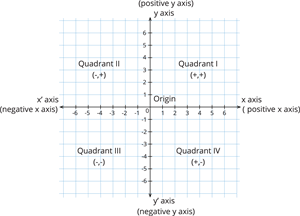
PUMPA - SMART LEARNING
எங்கள் ஆசிரியர்களுடன் 1-ஆன்-1 ஆலோசனை நேரத்தைப் பெறுங்கள். டாப்பர் ஆவதற்கு நாங்கள் பயிற்சி அளிப்போம்
Book Free DemoThe x - axis and y - axis divide the cartesian plane into four regions from the origin. These are called quadrants. They are usually numbered in anticlockwise direction starting from the region bounded by positive x and y axis (that is OX).
Quadrant I:
- Any point located in quadrant I will have a positive number in the x - axis and y - axis.
- That is, x > 0, y > 0.
- The region is XOY. Example:(2,3), (6,10), (9,12)
Quadrant II:
- Any point located in quadrant II will have a negative number in the x - axis and a positive number in y - axis.
- That is, x < 0, y > 0.
- The region is X'OY.Example:(-3,6), (-2,5), (-15,12)
Quadrant III:
- Any point located in quadrant III will have a negative number in the x - axis and y - axis.
- That is, x < 0, y < 0.
- The region is X'OY'.Example:(-5,-6), (-2,-1), (-8,-10)
Quadrant IV:
- Any point located in quadrant IV will have a positive number in the x - axis and a negative number in y - axis.
- That is, x > 0, y < 0.
- The region is XOY'.Example:(1,-3), (3, -4), (7,-1)

Coordinate of a point on the axes:
- If a point lies on the x - axis, then, the coordinate is (x,0). That is, y=0.Example:(-3,0), (6,0), (1,0).
- If a point lies on the y - axis, then, the coordinate is (0,y). That is, x=0. Example:(0,-1), (0,5), (0,10).